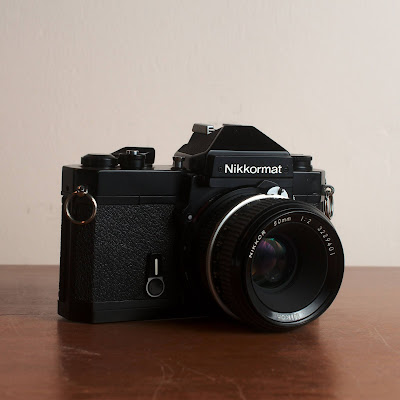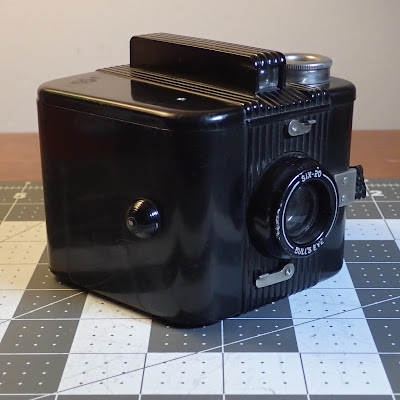The camera body is molded phenolic resin plastic. The front and back are die cast metal trimmed in black leatherette and chrome. The top of the camera has the film advance knob, the accessory shoe, the exposure dial, the film catch and the shutter button. The front of the camera has the shutter cocking lever, the range finder dial, the idler gear that connected the range finder to the lens, the lens, and the shutter speed dial. The bottom of the camera has the tripod socket and the film rewind knob. The back is hinged on the left and the latch is on the right. The camera does not have strap lugs. If you want to use a neck strap you put the camera in its case. Alternatively, you can use a strap that attaches to the tripod socket. The camera is more comfortable to hold when it is in its case.
The standard lens is an f/3.5-f/16, coated Argus Cintar lens with three elements in three groups. Because the lens rotates as it focuses the aperture ring has three scales around the perimeter so one is always easy to see from the top. There aren't any click stops. The lens will take Series V drop-in filters.
The shutter is a behind the lens leaf shutter with three blades. The shutter speed dial is marked from 1/300 to 1/10 second. For time exposures you turned the shutter button from "I" to "B" and used a cable release that screwed into the button. Argus used their "Color-matic" system to simplify exposure settings. For sunny day snapshots with ASA 10 Kodachrome film you used the yellow settings (f/6.3 and 1/50 second). With ordinary black and white film in sunny weather you used the red settings (f/8 and 1/100). The green setting (1/25) is for flash bulbs indoors or at night and has an icon of a flash bulb as an additional reminder. A label in the top of the leather case reminded you of the settings. With the standard 50mm lens you set the distance at 15 ft. (marked with triangles on the range finder dial) for subjects 10 or more ft. away to be in focus.
The viewfinder and range finder are separate. The viewfinder is a reverse galilean type that reduces the image by about half and shows the field of view of the standard 50 mm lens. The range finder is a split image type that is coupled to the lens by the idler gear. Turn the lens to focus. Your subject is in focus when the two halves visible in the range finder window are aligned. The range finder is not magnified.
The standard 50mm lens could be unscrewed and replaced with an Argus Sandmar 100mm telephoto lens or an Argus Sandmar 35mm wide angle lens. A viewfinder that slipped into the accessory shoe showed the correct fields of view for the 35mm and 100mm focal lengths. The accessory lenses were made by Enna-Werk, Munich, Germany. A Soligor 135 mm lens made in Japan was also available. The accessory lenses are coupled to the range finder by the same idler gear as the standard 50mm lens.
Argus made a flasholder that plugged into the right side of the camera. At some point the German company Kaiser made an adapter for flashes having standard PC sync connections. This adapter will work with electronic flashes.
An Argus LS-3 selenium cell light meter was available to fit the accessory shoe on the Standard C3. A modern light meter such as a Sekonic L-208 Twinmate will fit the accessory shoe.
To load film you open the back, put the film cassette into the right side of the camera and insert the leader into the take-up spindle on the left side of the camera. You next close the camera back and turn the film winding knob until it stops. To advance the film you push the film catch and turn the film advance knob about a quarter turn, let go of the film advance lever, and continue to turn the film advance knob until it stops. You do this twice more. The next step is to turn the exposure dial counterclockwise until zero is against the index mark. You are ready to make the first exposure. Check your focus, aperture and shutter speed, cock the shutter and press the shutter button, being sure to keep your fingers away from the shutter cocking lever. Advance the film immediately after taking a picture. There isn't any double exposure prevention or skipped frame prevention.
The C3 was one of the the most basic adjustable cameras you could buy.


















































